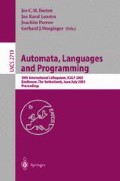Abstract
Modern hardware designs are typically based on multiple clocks. While a singly-clocked hardware design is easily described in standard temporal logics, describing a multiply-clocked design is cumbersome. Thus it is desirable to have an easier way to formulate properties relatedto clocks in a temporal logic. We present a relatively simple solution built on top of the traditional ltl-basedseman tics, study the properties of the resulting logic, andcompare it with previous solutions.
The work of this author was supportedin part by the John Von Neumann Minerva Center for the Verification of Reactive Systems.
Access this chapter
Tax calculation will be finalised at checkout
Purchases are for personal use only
Preview
Unable to display preview. Download preview PDF.
References
R. Armoni, L. Fix, A. Flaisher, R. Gerth, B. Ginsburg, T. Kanza, A. Landver, S. Mador-Haim, E. Singerman, A. Tiemeyer, M. Y. Vardi, and Y. Zbar. The ForSpec temporal logic: A new temporal property-specification language. In J.-P. Katoen and P. Stevens, editors, Proc. 8th International Conference on Tools and Algorithms for the Construction and Analysis of Systems (TACAS), volume 2280 of Lecture Notes in Computer Science. Springer, 2002.
E. Clarke and E. Emerson. Design andsyn thesis of synchronization skeletons using branching time temporal logic. In Proc. Workshopon Logics of Programs, LNCS 131, pages 52–71. Springer-Verlag, 1981.
C. Eisner and D. Fisman. Sugar 2.0 proposal presented to the Accellera Formal Verification Technical Committee, March 2002. At http://www.haifa.il.ibm.com/projects/verification/_sugar/Sugar_2.0_Accellera.ps.
M. J. C. Gordon. Using HOL to study Sugar 2.0 semantics. In Proc. 15th International Conference on Theorem Proving in Higher Order Logics (TPHOLs), NASA Conference Proceedings CP-2002-211736, 2002.
N. Halbwachs, P. Caspi, P. Raymond, and D. Pilaud. The synchronous data-flow programming language LUSTRE. Proceedings of the IEEE, 79(9):1305–1320, 1991.
J. Havlicek, N. Levi, H. Miller, and K. Shultz. Extended CBV statement semantics, partial proposal presentedto the Accellera Formal Verification Technical Committee, April 2002. At http://www.eda.org/vfv/hm/att-0772/01-ecbv_statement_semantics.ps.gz.
C. Liu and M. Orgun. Executing specifications of distributedcomputations with Chronologic(MC). In Proceedings of the 1996 ACM Symposium on Applied Computing (SAC), February 17–19, 1996, Philadelphia, PA, USA. ACM, 1996.
Z. Manna and A. Pnueli. Temporal Verification of Reactive Systems: Safety, pages 272–273. Springer-Verlag, New York, 1995.
M. Morley. Semantics of temporal e. In T. F. Melham and F. G. Moller, editors, Proc. Banff’99 Higher Order Workshop(F ormal Methods in Computation), 1999. University of Glasgow, Dept. of Computing Science Technical Report.
A. Pnueli. A temporal logic of concurrent programs. Theoretical Computer Science, 13:45–60, 1981.
F. Wang, A. K. Mok, and E. A. Emerson. Distributedreal-time system specification andv erification in APTL. ACM Transactions on Software Engineering and Methodology, 2(4):346–378, Oct. 1993.
Author information
Authors and Affiliations
Editor information
Editors and Affiliations
Rights and permissions
Copyright information
© 2003 Springer-Verlag Berlin Heidelberg
About this paper
Cite this paper
Eisner, C., Fisman, D., Havlicek, J., McIsaac, A., Van Campenhout, D. (2003). The Definition of a Temporal Clock Operator. In: Baeten, J.C.M., Lenstra, J.K., Parrow, J., Woeginger, G.J. (eds) Automata, Languages and Programming. ICALP 2003. Lecture Notes in Computer Science, vol 2719. Springer, Berlin, Heidelberg. https://doi.org/10.1007/3-540-45061-0_67
Download citation
DOI: https://doi.org/10.1007/3-540-45061-0_67
Published:
Publisher Name: Springer, Berlin, Heidelberg
Print ISBN: 978-3-540-40493-4
Online ISBN: 978-3-540-45061-0
eBook Packages: Springer Book Archive

